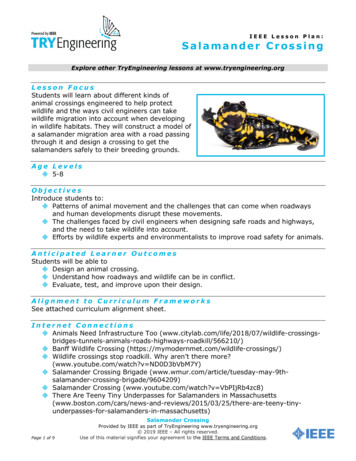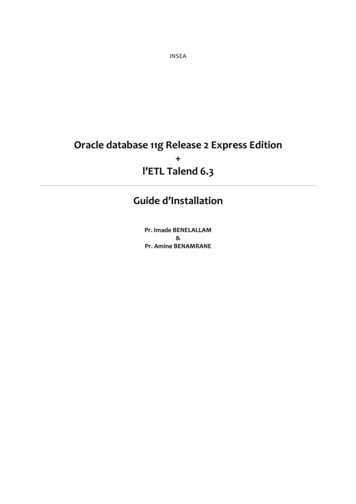
Transcription
IEEE Lesson Plan:Salamander CrossingExplore other TryEngineering lessons at www.tryengineering.orgLesson FocusStudents will learn about different kinds ofanimal crossings engineered to help protectwildlife and the ways civil engineers can takewildlife migration into account when developingin wildlife habitats. They will construct a model ofa salamander migration area with a road passingthrough it and design a crossing to get thesalamanders safely to their breeding grounds.Age Levels 5-8ObjectivesIntroduce students to: Patterns of animal movement and the challenges that can come when roadwaysand human developments disrupt these movements. The challenges faced by civil engineers when designing safe roads and highways,and the need to take wildlife into account. Efforts by wildlife experts and environmentalists to improve road safety for animals.Anticipated Learner OutcomesStudents will be able to Design an animal crossing. Understand how roadways and wildlife can be in conflict. Evaluate, test, and improve upon their design.Alignment to Curriculum FrameworksSee attached curriculum alignment sheet.Internet Connections Animals Need Infrastructure Too 10/) Banff Wildlife Crossing (https://mymodernmet.com/wildlife-crossings/) Wildlife crossings stop roadkill. Why aren’t there more?(www.youtube.com/watch?v ND0D3bVbM7Y) Salamander Crossing Brigade ossing-brigade/9604209) Salamander Crossing (www.youtube.com/watch?v VbPIjRb4zc8) There Are Teeny Tiny Underpasses for Salamanders in lamanders-in-massachusetts)Salamander CrossingPage 1 of 9Provided by IEEE as part of TryEngineering www.tryengineering.org 2019 IEEE – All rights reserved.Use of this material signifies your agreement to the IEEE Terms and Conditions.
Recommended Reading Salamander Sky by Katy Farber (ISBN: 978-0999076644) Amphibian by Barry Clarke (ISBN: 978-0756613808) Salamander Dance by David FitzSimmons (ISBN: 978-1936607006) How Do Wildlife Crossings Save Animals? (ISBN: 978-1543541380)Optional Writing ActivityThink about where you live and the types of wildlife you encounter. Are there areaswhere these encounters are problematic? Or where natural movements of animals aredisrupted? What do you think should be done to help keep humans and animals safe?If you could design a new structure in your community, or change an existing one,what would it be?Salamander CrossingPage 2 of 9Provided by IEEE as part of TryEngineering www.tryengineering.org 2019 IEEE – All rights reserved.Use of this material signifies your agreement to the IEEE Terms and Conditions.
IEEE Lesson Plan:Salamander CrossingFor Teachers:Teacher Resource Anticipated Learner OutcomesStudents will be able to: Design an animal crossing. Understand how roadways and wildlife can be in conflict. Evaluate, test, and improve upon their design. Materials Play dough, in multiple colors (including blue, green, and black) Play dough tools (optional, mainly rollers/rolling pins) Small drawings or photos of spotted salamanders (should be small enough to fiteasily through a paper towel roll. Paperclips String Strips of paper or cardstock Scissors Paper towel and toilet paper rolls Tape Trays or small boxes or box tops (optional) Natural material (optional), like twigs, pine needles, and leaves, which can be usedto represent different natural areas in the model Procedure1. Students should read the Student Resource as homework the night before or inclass before beginning the activity. This will introduce them to the issue of wildlifecrossings and the challenges facing salamanders as they make the springtimemigration from their wooded homes to the vernal pools where they breed. Studentscould also watch the video, Wildlife crossings stop roadkill. Why aren’t there more?(www.youtube.com/watch?v ND0D3bVbM7Y), either in class or at home, whichprovides a good introduction to the issue and shows some examples of successfulanimal crossings.2. Students will then cut out a small picture of a spotted salamander and tape it to apaperclip. They will then tie a string to the end of the paperclip.3. Students will work with playdough to create a model of a salamander crossing zone.This can be done on a table or desk, or in a tray, shallow box, or box top. Themodel should include a wooded area on one side, a vernal pool on the other side,and a road running in between.4. The goal of the activity is for students to change the model in order to construct away for the salamander to get from the woods to the vernal pool without having tocross the road, where it would risk getting hit by a car. To test their design,students will place their salamander in the woods and use the string to pull thesalamander across the model and over to the vernal pool. The toilet paper rolls canbe used to construct bridges or tunnels, the paper strips can be used as fences orSalamander CrossingPage 3 of 9Provided by IEEE as part of TryEngineering www.tryengineering.org 2019 IEEE – All rights reserved.Use of this material signifies your agreement to the IEEE Terms and Conditions.
guides, and the road can be lifted, lowered, or otherwise moved in order to create asolution.5. Once students have tested their designs, they should consider what worked andwhat didn’t. Students can redesign their crossing if needed. Since salamandersneed to stay damp to survive, students should think about and be prepared toexplain how their crossing takes this into account.6. Students will share their salamander crossings with one another.7. Students will use the Student Worksheet to evaluate how their design worked, whatproblems they encountered, and what changes they could make to improve theirdesign.Salamander CrossingPage 4 of 9Provided by IEEE as part of TryEngineering www.tryengineering.org 2019 IEEE – All rights reserved.Use of this material signifies your agreement to the IEEE Terms and Conditions.
IEEE Lesson Plan:Salamander CrossingStudent Resource: Why Did the Salamander Cross the Road?Every spring as temperatures start to rise, onwet, rainy nights, salamanders make the journeyfrom the forests where they live as adults to thevernal pools where they breed, lay their eggs,and the hatched larvae begin their lives living inthe water. When these baby salamandersbecome juveniles, they will make the journeyback to the forest until it’s time to return to thewater as adults to breed and lay their own eggs.In order to reach these breeding sites, salamanders often have to cross over roads,meaning that many adult salamanders risk being run over by cars. It is estimated thatmortality rates for adult salamanders crossing roads can often be as high as 50 to 100%,meaning that local salamander populations can quickly be wiped out. Chemical run-offfrom cars can also pollute roadside waterways, which can damage eggs and embryodevelopment, meaning fewer salamander eggs are able to successfully hatch babysalamanders.Conservationists have tried many methods to help salamanders and other amphibians onthese migration nights. Some have started Salamander Crossing Brigades made up ofvolunteers who scan the roads, picking up any amphibians they find and carrying themsafely to the other side of the road. During these nights, volunteers also help to collectdata that has helped to change policies and save more amphibians. Some conservationistshave successfully lobbied to have roads known for busy amphibian crossings closed forthe busiest month. Data collected about amphibian migrations has helped to protect landscheduled for development. And in some places, special crossings have been built toprovide salamanders with alternative ways to safely access their breeding pools. The firstamphibian underpass was built at a busy migration site in Amherst, Massachusetts in1987.Other Wildlife CrossingsIn addition to salamanders and otheramphibians, wildlife of all sorts can comeinto harm’s way when a roadway crossesthrough its habitat. And that harm reacheshumans too. When large animals likemoose and bears try to cross roads andhighways, they become a danger to driversas well.In Banff National Park in Canada,authorities began creating a series ofSalamander CrossingPage 5 of 9Provided by IEEE as part of TryEngineering www.tryengineering.org 2019 IEEE – All rights reserved.Use of this material signifies your agreement to the IEEE Terms and Conditions.
underpasses and overpasses in known wildlife crossing areas. There had been more than100 elk-vehicle collisions a year. Now there are less than 6. The crossings are plantedwith native vegetation, and fences along the highway are used to guide animals towardthe crossings. You can view these bridges here: https://mymodernmet.com/wildlifecrossings/In Florida, underpasses have been designed for black bearsand alligators. In Santa Monica, California wildlife corridorshave been proposed for animals such as mountain lions,bobcats, and coyotes, which are often hit by cars whiletrying to cross highways into the Santa Monica Mountains.In Eastern Canada, moose can be a dangerous road hazard.Tall moose fences, which allow moose to exit the highway,but not to return, have been built along large stretches ofthe Trans-Canada Highway.In Vermont, the Fish and Wildlife Department and theAgency of Transportation are working with the NatureConservancy, using game cameras to track if and how animals are navigating developedareas that interrupt blocks of forest. In areas where they have spotted wildlife traffic, theyare creating dirt paths over large rocks, adding trees, and making other changes so thesepathways are easier to cross.In Warwick, England people were so concerned about amphibians getting trapped indrains that they installed mesh-covered ladders in drains near known breeding pools.These allow any amphibians that may get washed into drains while crossing the road toclimb back out before being trapped for good.The picture to the right shows an overpass inThailand that allows animals to walk on thegrass and safely cross the road.The risks to wildlife extend beyond roads, too.Dams can block eel migrations to importantupstream habitats where they will feed andmature. To help solve the problem, some damshave installed eel ladders—ramps that eels canpush against while slithering upstream, safelymoving over the hydroelectric dams.With climate change, it’s expected that animal migration patterns will change and thatwildlife will need to migrate further than before in order to survive. This could mean evenmore issues when it comes to roads and animal movement.Many people are thinking about animals and how roads can be safer for both humans andwildlife. Wildlife crossings work—protecting animal populations and keeping drivers safe.So why aren’t there more wildlife crossings? The main obstacle is cost. But in some placesplanners and engineers are beginning to include wildlife habitats and migration in theirplans from the beginning, making them more cost effective, safer for drivers, and betterfor animals.Salamander CrossingPage 6 of 9Provided by IEEE as part of TryEngineering www.tryengineering.org 2019 IEEE – All rights reserved.Use of this material signifies your agreement to the IEEE Terms and Conditions.
IEEE Lesson Plan:Salamander CrossingStudent Worksheet:In the springtime, adult salamanders leave their forest homes and return to vernal poolswhere they breed and lay eggs. If a roadway exists between these two habitats, theyhave to cross the road to reach this very important destination. In this activity, you will bechallenged to create a way to get these salamanders safely from one side of the road tothe other.Making Your SalamanderCut out the salamander below and tape it to a paperclip. Next, tie the piece of string tothe paper clip. This will be the salamander you need to help get from the woods to thevernal pool.Building Your HabitatUsing playdough, construct a model of a salamander crossing zone. The model shouldinclude a wooded area on one side, a vernal pool on the other side, and a road running inbetween.The ChallengeYour goal is to change the model into a salamander-friendly habitat by constructing a wayfor the salamander to get from the woods to the vernal pool without having to cross theroad. You can use any of the materials provided to create your salamander crossing.Remember that you may need to build something to help guide salamanders to yourcrossing as well. Salamanders also have to remain damp in order to survive. Think abouthow your crossing will allow for this.The TestOnce you have constructed your salamander crossing, place your salamander in thewoods and pull your salamander through the crossing using the string (it can be threadedthrough tunnels, etc., if necessary). Evaluate how your crossing worked and how it couldbe improved. If time allows, revise your design and retest it.Salamander CrossingPage 7 of 9Provided by IEEE as part of TryEngineering www.tryengineering.org 2019 IEEE – All rights reserved.Use of this material signifies your agreement to the IEEE Terms and Conditions.
IEEE Lesson Plan:Salamander CrossingStudent Worksheet: Reflection1. What method did you choose for your salamander crossing? Why? How will your designmake sure salamanders can stay damp?2. How did your crossing work when you tested it? Were there any problems?3. How do you think you could improve upon your design? What changes would you maketo it?4. What ideas did your classmates come up with that you liked? Are there any ideas youwould want to incorporate into your design?Salamander CrossingPage 8 of 9Provided by IEEE as part of TryEngineering www.tryengineering.org 2019 IEEE – All rights reserved.Use of this material signifies your agreement to the IEEE Terms and Conditions.
IEEE Lesson Plan:Salamander CrossingFor Teachers:Alignment to Curriculum FrameworksNote: Lesson plans in this series are aligned to one or more of the following sets of standards: U.S. Next Generation Science Standards (www.nextgenscience.org) U.S. Common Core State Standards for Mathematics (www.corestandards.org/Math) International Technology Education Association's Standards for Technological Literacy(http://www.iteea.org/TAA/PDFs/xstnd.pdf) Computer Science Teachers Association K-12 Computer Science andards.html) Next Generation Science Standards - Grades K-2 (Ages 5-8)K-ESS3-1 Earth and Human Activity Use a model to represent the relationship between the needs of differentplants and animals (including humans) and the places they live.K-ESS3-3 Earth and Human Activity Communicate solutions that will reduce the impact of humans on the land,water, air, and/or other living things in the local environment.K-2-ETS1-1 Engineering Design Ask questions, make observations, and gather information about a situationpeople want to change to define a simple problem that can be solved throughthe development of a new or improved object or tool.K-2-ETS1-2 Engineering Design Develop a simple sketch, drawing, or physical model to illustrate how theshape of an object helps it function as needed to solve a given problem. Standards for Technological Literacy - All AgesThe Nature of Technology Standard 3. Students will develop an understanding of the relationshipsamong technologies and the connections between technology and other fieldsof study.Technology and Society Standard 5. Students will develop an understanding of the effects oftechnology on the environment. Standard 6. Students will develop an understanding of the role of society inthe development and use of technology.Design Standard 9: Students will develop an understanding of engineering design.Abilities for a Technological World Standard 13. Students will develop abilities to assess the impact of productsand systems.The Designed World Standard 20. Students will develop an understanding of and be able to selectand use construction technologies.Salamander CrossingPage 9 of 9Provided by IEEE as part of TryEngineering www.tryengineering.org 2019 IEEE – All rights reserved.Use of this material signifies your agreement to the IEEE Terms and Conditions.
and alligators. In Santa Monica, California wildlife corridors have been proposed for animals such as mountain lions, bobcats, and coyotes, which are often hit by cars while trying to cross highways into the Santa Monica Mountains. In Eastern Canada, moose can be a dangerous road hazard.











